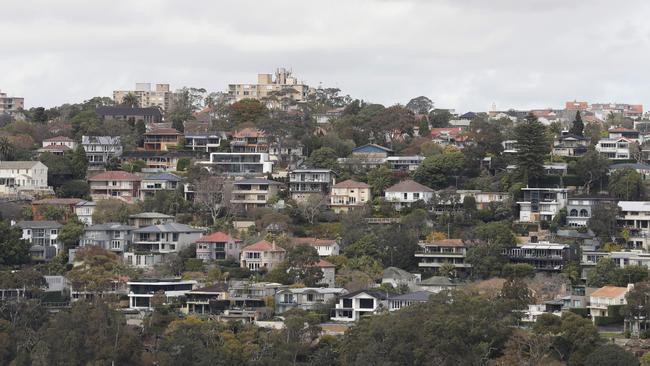The (peak) time of our life: Ages at which Australians pass through life stages
What is the peak year for marriage, mortgages, kids and income-earning capacity? These are important questions for the property industry and others.
Business
Don't miss out on the headlines from Business. Followed categories will be added to My News.
In what year of the life cycle are Australians most likely to be married, to have children, to peak in their income-earning capacity? These are important questions for the property industry and for Australians more generally.
The real value of this kind of analysis, which seeks out the various “peak times” of our lives, is best revealed when it is applied to the 2021 Census. This delivers metrics-based proof of when Aussie peak across the life cycle.
For example, this shows that across the early-20s, Australians are more likely to prefer a de facto relationship than commit to a registered marriage.
Indeed, at the age of 21, Australians are 10 times more likely to be in a de facto relationship than in a registered marriage.
The flip year, when registered marriages outnumber de facto relationships, is the age of 29. In that year, there were 89,000 Aussies in de facto relationships versus 96,000 in registered marriages, according to the census.
The age of 29 could be viewed as the time in the life cycle when Australians decide they want the so-called security of marriage in order to start a family and to take out a mortgage.
On these figures, the first-home buyer market accelerates from the late-20s onwards.
The time in the life cycle when Australians are most likely to describe their relationship status as separated is late 40s for women (6 per cent peak age 47) and early 50s (5 per cent peak age 52) for men.
The late-40s/early-50s is clearly a testing time for relationships; it coincides with the arrival of teenagers in the family home and with rising work/financial pressures.
Peak (full-time) median income is reached at age 43, up from 41 at the 2016 census.
Maybe separation follows the realisation that by the late-40s career-peak earning capacity has come and gone?
Australians are most likely to describe their relationship status as divorced at the age of 64; this peak applies to men and women. The proportions are 20 per cent for women and 16 per cent for men.
There are different housing needs at each stage of the life cycle:
● a rented apartment suits an early-20s de facto relationship;
● an affordable first home is needed by a late-20s/early-30s couple;
● a suburban townhouse may suit a separated father (aged 52) wanting nearby access to kids;
● a low-maintenance sea-change property might suit a mid-60s divorcee.
The true value of the census is that it quantifies and confirms the key markets, generally well understood by the property industry.
But there is far more insight to be gained by looking at life-cycle responses to other census questions.
For example, at an aggregate level, some 42 per cent of Australians reported at the census that they had no religious affiliation. This proportion (of non believers) rises to a peak of 54 per cent at the age of 28.
Thereafter, “godliness”, however it may be defined, gathers momentum. Religious affiliation gains ground for couples when their relationship shifts from de facto to registered marriage and when children arrive.
The proportion of Australians reporting some kind of religious affiliation hovers around the 80 per cent mark in every year beyond 80.
There are none so devout as the aged and, generally, the older, the greater the commitment to religious affiliation.
Older, married Australians, with children, even after kids have left the family home, retain traditional values when it comes to matters of belief.
One question in the 2021 Census asked about unpaid caregiving to a family member or person in need. At an aggregate level, some 13 per cent of the Australian adult population (aged 15-plus) say they are unpaid caregivers. This proportion peaks at 25 per cent of the population for 57-year-old women. The peak for men is 16 per cent at the age of 61.
My reading of the caregiving dataset is that this activity peaks as late-50-somethings provide unpaid care for elderly parents (and parents-in-law) in their 80s.

As these elderly parents “die off” (with “kids” aged 57-61) caregiving Australians are then freed, and maybe even empowered by an inheritance, to make other lifestyle and housing choices.
We Australians are a “giving” lot. This much is evident in the census question relating to volunteering. Some 15 per cent of adult Australians reported volunteering at the last census.
This proportion peaked at 20 per cent for women aged 42-46 and at 19 per cent for men aged 71-76. The time in the life cycle when Australians are least likely to volunteer is 24-36 when this proportion drops to 11-12 per cent.
Volunteering is closely associated with the raising of and caring for children. It may be assumed, therefore, that the time in the life cycle when Australians need a large “forever” house to accommodate young kids and teenagers is across the early to mid-40s.
These are also the years in which parents are most likely to support school and (kids’) sporting events.
Interestingly, the peak age at separation for women (46) occurs at the end of the peak period of volunteering (42-46): perhaps sheer exhaustion is a contributing factor that leads to peak separation.
A new question at the 2021 Census asked if respondents had been told by a doctor or nurse that they have a long-term mental health condition, namely anxiety and/or depression. Some 10 per cent of the population answered yes to this question.
This condition reaches a peak of 19 per cent for females aged 23. The proportion for men hovers around 9 per cent between the ages of 20 and 40. However, I wonder whether men, for whatever reason, are answering this question accurately.
There’s another insight to be gained from the question of mental health. The condition for women subsides throughout the life cycle to reach a low point of 10 per cent and less between the ages of 65 and 85.
For men, this “grandparent” stage in the life cycle is also less likely to be associated with mental health conditions like depression and anxiety.
If there is a period of “greatest contentment” in life, as measured by an absence of anxiety and depression, then it is surely the first 20 years of retirement.
Thereafter, however, mental health conditions worsen, rising to 15-20 per cent of the population for 90-something women and only slightly less for men (10-14 per cent). I suspect that the Great Contentment era (65-85) of the life cycle is associated with the arrival of and engagement with grandchildren.
It possibly also reflects a shift in personal values and thinking that occurs later in life.

This “golden era” kicks off at age 65 which is one year after the time when most Australians describe their relationship status as divorced.
It is an era of letting go, of personal growth and of change, of finally accepting both the trials and the tribulations of life.
Or at least this is the way the 65-85 stage-of-the-life cycle looks when tracking mental health conditions via the census.
The post-85 worsening of mental health is likely to be associated with a rise in loneliness as life partners died off.
When a number of census metrics are viewed across the life cycle it is evident that in aggregate, we Australians hold traditional values and especially when it comes to matters relating to children and the family (and by extension to “the family home”).
We are happy to trial relationships throughout our early to mid-20s.
But by age 28 we want the security of a registered marriage.
Children arrive and, all of a sudden, our values, as expressed through the census, shift: from the late-20s onwards we increasingly (and officially at least) adhere to some kind of religious affiliation.
Across the 30s, careers, housing and kids drive our priorities. Peak income isn’t reached until the early 40s.
Young families are drawn into the community via volunteering. By the late 40s, some relationships are strained to the point of separation.
But divorced Australians don’t technically peak until the age of 64 which suggests that there’s re-partnering going on for women from the late 40s and for men from the early 50s. Housing requirements morph as these key household relationships change.
However, while separations and divorce are a growing part of modern life, the vast majority hold fast to this traditional institution.
About 60 per cent of Australians describe themselves as “married” from the age of 37 onwards; this proportion doesn’t drop below 60 per cent until the late 70s, and then it is only because many transfer out of “married” into “widowed”.
The big issue for the next five years is that the Millennial generation is now passing into the early-40s stage of the life cycle, prompting demand for lifestyle “family” housing.

This will be difficult to supply in a time of strained resources, limited labour and rising costs.
Later this decade and into the early 2030s, there is another life stage awaiting the Millennials, and that is the challenge of navigating the stresses that lead to separation and divorce.
Older Australians, on the other hand, will continue to head into what might be called the contentment years as grandchildren arrive and the pressures of everyday life recede.
The census doesn’t deliver boring data, it tells compelling “human” stories of the life and times of the Australian people.
Bernard Salt is founder of The Demographics Group; research and data by data scientist Hari Hara Priya Kannan.





